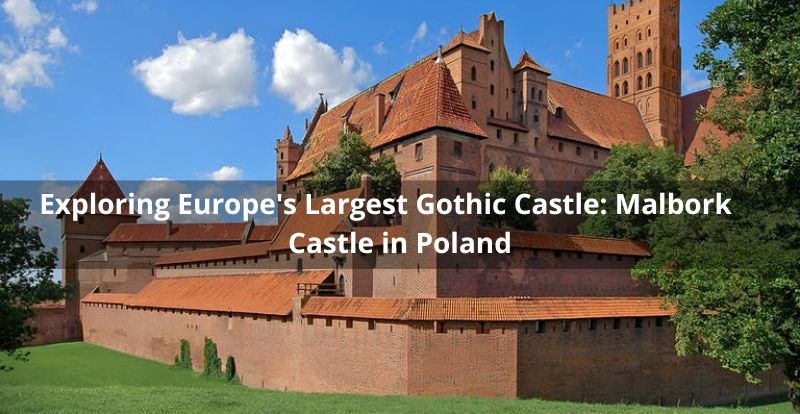Exploring Europe's Largest Gothic Castle: Malbork Castle in Poland
Exploring Europe's Largest Gothic Castle: Malbork Castle in Poland. Nestled along the banks of the Nogat River in northern Poland stands a testament to medieval craftsmanship and military might: Malbork Castle. This colossal fortress, boasting striking red brick walls and formidable defenses, has stood the test of time since its construction in the 13th century. Once a stronghold of the Teutonic Order, Malbork Castle now stands as the largest gothic castle in Europe, a proud symbol of Poland's rich history and architectural heritage.
It may interest you: The Quest for Light in Gothic Architecture - Exploration in Medieval Christian Art
Video: Exploring the World's Largest Castle | Malbork Castle, Poland (VLOG)

The Grandeur of Malbork Castle - Gothic Castle
Building a Fortress: The Origins of Malbork Castle
The story of Malbork Castle begins in the 13th century, when Duke Konrad of Masovia forged agreements with the Teutonic Order, a medieval religious and military organization. In 1274, the Teutonic Knights embarked on the construction of a fortress in Malbork, which would later evolve into the royal residence of Polish monarchs. Originally established to spread Christianity in the region, the castle underwent significant transformations over the centuries to accommodate the needs of the Teutonic Order.
Evolution of a Stronghold: The Three Castles of Malbork
The architectural ensemble of Malbork Castle is comprised of three distinct sections: the High Castle, the Middle Castle, and the Outer Bailey. The High Castle, fortified with double walls and moats, was initially constructed to house the Teutonic Knights and features notable structures such as the Church of the Virgin Mary and the Chapel of St. Anne. Subsequent expansions led to the creation of the Middle Castle, a residence for visiting knights, and the completion of the Lower Castle, which included facilities such as the Karwan Hall and the Chapel of St. Lawrence.
Historic Battles and Transformations
Throughout its tumultuous history, Malbork Castle witnessed numerous conflicts and sieges, including the pivotal Battle of Grunwald in 1410. Despite facing setbacks, such as the temporary loss of control to Polish forces, the Teutonic Order persevered and continued to fortify the castle. Following the conclusion of the Thirteen Years' War in 1466, Malbork Castle became the seat of Polish monarchy and served as a symbol of national pride until the partitions of Poland in the late 18th century.
Preservation and Legacy
Despite enduring significant damage during World War II, Malbork Castle was meticulously restored to its former glory in the post-war era, preserving its distinctive gothic architecture. In recognition of its historical significance, the castle was designated a UNESCO World Heritage Site in 1997 and remains under the protection of the Polish government. Today, Malbork Castle stands as a living museum, offering visitors a glimpse into the medieval past of Poland and the legacy of the Teutonic Knights.
Exploring Malbork Castle
Visitors to Malbork Castle are treated to a wealth of historical and architectural wonders. From the original gothic structures of the Middle Castle to the grandeur of the Grand Masters' Palace, there is much to discover within the castle walls. Highlights include the Church of the Virgin Mary, the Tower of Gdansk, and the burial site of the Grand Masters. After a day of exploration, visitors can indulge in traditional Polish cuisine at Piwiniczka, the castle's onsite restaurant.
Beyond its architectural significance, Malbork Castle serves as a cultural hub, hosting various events and exhibitions throughout the year. Visitors can immerse themselves in the medieval atmosphere through reenactments, concerts, and educational programs that bring the castle's storied past to life. Additionally, the castle's museum offers a wealth of artifacts and exhibits detailing the history of the Teutonic Order, providing visitors with a deeper understanding of the castle's role in shaping European history.
Planning Your Visit
For those planning a visit to Malbork Castle, there are several practical considerations to keep in mind. The castle is open to the public year-round, with guided tours available in multiple languages to accommodate international visitors. It's advisable to check the castle's website for any special events or closures before planning your trip. Additionally, visitors should allocate ample time to explore the vast complex, as there is much to see and experience within its walls.
A Jewel of Europe's Gothic Heritage, Malbork Castle stands as a testament to the ingenuity and resilience of medieval builders and warriors. From its humble beginnings as a fortress on the banks of the Nogat River to its modern-day status as a UNESCO World Heritage Site, Malbork Castle continues to inspire awe and admiration in all who visit. As Europe's largest gothic castle, it remains a cherished symbol of Poland's rich cultural heritage and a reminder of the enduring legacy of the Teutonic Order.
Si quieres conocer otros artículos parecidos a Exploring Europe's Largest Gothic Castle: Malbork Castle in Poland puedes visitar la categoría Gothic.

Leave a Reply